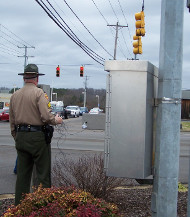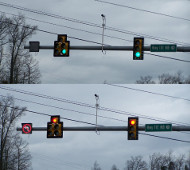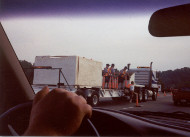200,000 Football Fans to Converge for Battle at Bristol in September
by David Metzger, City of Bristol
Since 1961, Bristol Motor Speedway (BMS) has been hosting NASCAR races for hundreds of thousands of race fans, and the facility has grown over the years to its current capacity of 164,000 persons. In terms of number of seats, this is one of the top five stadiums on the planet. Between the racing action on the track and the thousands of throats cheering or booing, BMS roars with sound during Race Weekend.
Yet, come September 10, 2016, BMS will ring with a different kind of roar, as temporary stands on the racetrack surface itself raise the seating capacity to 200,000 persons cheering on the game between the University of Tennessee and Virginia Tech in the Battle at Bristol, smashing the old nationwide record for largest attendance at a college football game. In a period of about three weeks, BMS has to transform itself from a topnotch racing venue following the August Race Weekend to a one-of-a-kind football stadium, complete with all the required accoutrements for NCAA football. The excitement of the football game already has everyone talking from Knoxville to Blacksburg.

For the City of Bristol and the other eight cities, six counties, three state police agencies, two state departments of transportation, multiple federal agencies, and the Cumberland Gap Tunnel Authority that work BMS traffic, the Battle at Bristol presents another challenge...how to ensure that those 200,000 football fans, of which it is estimated that 60 percent have not been to BMS before, will get to and from the game and stay safe during their visit. These different governments and agencies have long worked together to make the race traffic flow to and from BMS; a full sell-out for an August Race Weekend translates into about 700,000 vehicles flowing around BMS over a 4.5-day period.
"The basic traffic plan for a Race Weekend at Bristol Motor Speedway has evolved over the years as BMS has grown, and has proved very successful in its execution," said David Metzger, Traffic Engineer for the City of Bristol and a coordinator of traffic operations for Race Weekend. "However, we can't just take the race traffic plan, change the dates, and call it sufficient for the Battle at Bristol. We recognize that we are dealing with a different type of population....less multi-day camping, more day of-event traffic...tailgating activities in the parking lots that can consume parking capacity...timing changes because football doesn't stop for inclement weather the same way that a NASCAR race does...differences in how the competitors arrive at the venue...the differences go on and on." While officials are confident that the 225 recognized camping and day-parking fields that surround BMS within a three-mile radius will have sufficient capacity for the Battle at Bristol, BMS has gained control over four of the largest campgrounds and designated two for UT fans and two for VT fans.

Some of the features of the race traffic plan that will again be used for the Battle at Bristol include tried-and-true techniques such as manual control of traffic signals over multiple jurisdictions; three sets of contraflow lanes; lane closures on Interstate 81 to control merging movements; turn prohibitions at key locations; closures of median openings; and thousands of traffic control devices spread out over a 150-mile radius of Bristol. As with all such events, a partnership between traffic engineering, public works, and public safety agencies also means traffic support for such items as pre-designated temporary landing zones for helicopters working medical evacuations; enhanced navigation mileposts and E-911 landmarks; and pre-emption of traffic signals for emergency vehicles.
Parking control is very important; keeping medians, shoulders, and even some grassy areas behind the shoulders clear of parked vehicles means that pedestrians have a place to walk outside of the travel lanes; emergency vehicles have travel options; motorists don't park facing the wrong way for post-event one-way flows; and sight distance is maintained at intersections to the appropriate standards. Recent Race Weekends have averaged one illegally-parked vehicle tow per Race Weekend among the 65,000 vehicles in the area.
Coordination and communication for such a massive event is key to its success. The Multi-Agency Command Center in Bristol, Tennessee, in communication with its counterpart in Bristol, Virginia, as well as the traffic management centers in Knoxville and Roanoke, work in concert to keep traffic flowing. Static signage, both permanent and portable variable message boards, live radio broadcasts, Wizard Radio (a device used by the Virginia DOT to mass-communicate with truckers over Citizen's Band radio) and myriad other devices keep the motoring public advised as to traffic conditions, crash locations, tips to post-event travel, parking restrictions, and other atypical traffic characteristics.

"One of the challenges to event traffic is the fact that commercial mapping software and GPS are typically not aware of event-day lane and ramp closures, turn prohibitions, and similar features that are common to special event traffic," said Metzger. "Someone relying only on their GPS and not paying attention to the signs and police officers can find themselves in the wrong place at the wrong time."
The ten major signed routes carrying post-event traffic away from BMS will be used again after the Battle at Bristol. A longtime goal is to balance the level of congestion between these routes, so that there isn't one or two heavily congested routes and eight lightly used routes. Sometimes race fans wanting to go west find themselves going east to get to I-81 or I-26 after a race. "In ancient times, all roads led to Rome; after an event at BMS, all roads lead to the Interstate," said Metzger, "just follow the signs." As with all special events, the cooperation of the motoring public is key to successful event traffic flow.
Back-Contents-Forward